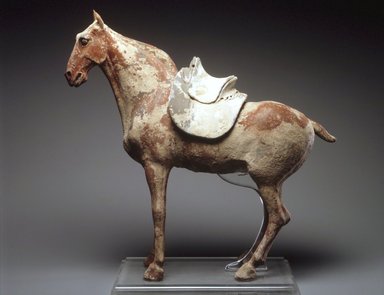
Medium: Earthenware, traces of pigment
Geograhical Locations:
Dates:late 6th century
Dimensions: 19 1/2 x 22 x 5 1/2 in. (49.5 x 56.0 x 14.0 cm)
Collections:
Museum Location: Asian Galleries, West, 2nd floor (China)
Exhibitions:
Accession Number: 1999.138a-b
Image: 1999.138a-b_transp4807.jpg,
Catalogue Description: Chinese ceramic tomb figure of a horse with a separate saddle, the horse standing on four legs without a base, the figure molded and hand-finished, the clay body fired a deep, even gray color, the horse painted a deep red-brown pigment and covered with an encrustation of soil from burial, the soil and paint flaking unevenly from the surface. The ends of an iron armature are visible on the bottom three of the four hooves. The body of the horse is especially thick, the interior visible through a large opening on the horse's stomach, with finger marks from the original modeling visible around the opening and the impression of a bundle of coarse straw or similar material in the interior of the horse's body, the straw lost during firing. The saddle is molded and hand finishes, with traces of red-brown pigment on some details and white-gray pigment on the seat. Adhesive label on the underside of the saddle from Christie's\23mar95\101 (?)\30. With the introduction of the famous Fereghan horses from Central Asia, the course of Chinese history shifted significantly. Warfare, pageantry, and trade were affected by this development, as was Chinese art. The realistic modeling of these two sixth-century horses represents a long tradition of the equine form in funerary sculpture. The dynamic movement portrayed by the figure's turned torso is a new element of the era. Saddles became important decorative objects themselves in later periods, as shown by the silver saddle ornaments also displayed here. (Gallery Chat Label, 2007 - shared with 37.126) Condition: The horse and saddle are currently intact, with evidence of previous damage and repair, especially to the legs of the horse. Firing cracks visible inside the body. Evidence of some overpainting in red-brown to match the original color and to cover losses of original pigment of burial encrustation. Recommend non-obtrusive examination to identify areas of repair and/or restoration, as well as to locate the original iron armature.